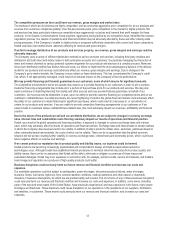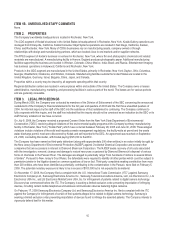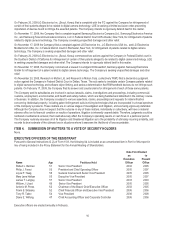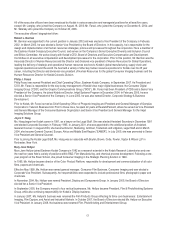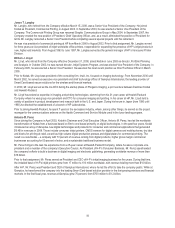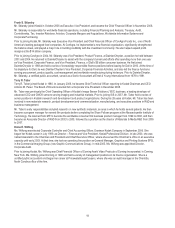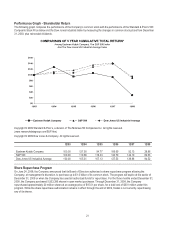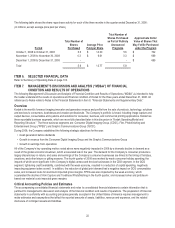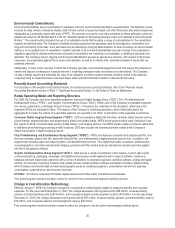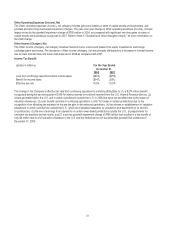Kodak 2008 Annual Report Download - page 25
Download and view the complete annual report
Please find page 25 of the 2008 Kodak annual report below. You can navigate through the pages in the report by either clicking on the pages listed below, or by using the keyword search tool below to find specific information within the annual report.23
The Company believes that the critical accounting policies and estimates discussed below involve the most complex management
judgments due to the sensitivity of the methods and assumptions necessary in determining the related asset, liability, revenue and
expense amounts. Specific risks associated with these critical accounting policies are discussed throughout this MD&A, where such
policies affect our reported and expected financial results. For a detailed discussion of the application of these and other accounting
policies, refer to the Notes to Financial Statements.
Revenue Recognition
The Company's revenue transactions include sales of the following: products; equipment; software; services; equipment bundled
with products and/or services and/or software; integrated solutions, and intellectual property licensing. The Company recognizes
revenue when it is realized or realizable and earned. For the sale of multiple-element arrangements whereby equipment is combined
with services, including maintenance and training, and other elements, including software and products, the Company allocates to,
and recognizes revenue from, the various elements based on their fair value.
At the time revenue is recognized, the Company also records reductions to revenue for customer incentive programs in accordance
with the provisions of Emerging Issues Task Force (“EITF”) Issue No. 01-09, "Accounting for Consideration Given from a Vendor to a
Customer (Including a Reseller of the Vendor's Products)." Such incentive programs include cash and volume discounts, price
protection, promotional, cooperative and other advertising allowances and coupons. For those incentives that require the estimation
of sales volumes or redemption rates, such as for volume rebates or coupons, the Company uses historical experience and internal
and customer data to estimate the sales incentive at the time revenue is recognized. In the event that the actual results of these
items differ from the estimates, adjustments to the sales incentive accruals would be recorded.
Incremental direct costs of a customer contract in a transaction that results in the deferral of revenue are deferred and netted against
revenue in proportion to the related revenue recognized in each period if: (1) an enforceable contract for the remaining deliverable
items exists; and (2) delivery of the remaining items in the arrangement is expected to generate positive margins allowing realization
of the deferred costs. Incremental direct costs are defined as costs that vary with and are directly related to the acquisition of a
contract, which would not have been incurred but for the acquisition of the contract.
Valuation of Long-Lived Assets, Including Goodwill and Purchased Intangible Assets
The Company reviews the carrying value of its long-lived assets, including goodwill and purchased intangible assets, for impairment
whenever events or changes in circumstances indicate that the carrying value may not be recoverable.
The Company tests goodwill for impairment annually (on September 30), or whenever events occur or circumstances change that
would more likely than not reduce the fair value of a reporting unit below its carrying amount, by initially comparing the fair value of
each of the Company’s reporting units to their related carrying values (step one). If the fair value of the reporting unit is less than its
carrying value, the Company must determine the implied fair value of goodwill associated with that reporting unit (step two). The
implied fair value of goodwill is determined by first allocating the fair value of the reporting unit to all of its assets and liabilities and
then computing the excess of the reporting unit’s fair value over the amounts assigned to the assets and liabilities. If the carrying
value of goodwill exceeds the implied fair value of goodwill, such excess represents the amount of goodwill impairment charge that
must be recognized. The Company’s goodwill impairment analysis also includes a comparison of the aggregate estimated fair value
of all reporting units to its total market capitalization.
Determining the fair value of a reporting unit involves the use of significant estimates and assumptions. The Company estimates the
fair value of its reporting units utilizing income and market approaches through the application of discounted cash flow and market
comparable methods. Key assumptions used to determine the fair value of each reporting unit as of the Company’s fiscal annual
testing date (September 30, 2008) were: (a) expected cash flow for the period from 2009 to 2013; and (b) discount rates of 14% to
17.5%, which were based on the Company’s best estimates of the after-tax weighted-average cost of capital of each reporting unit.
Based upon the results of its September 30, 2008 analysis, no impairment of goodwill was indicated.
As of December 31, 2008, due to the continuing challenging business conditions and the significant decline in its market
capitalization during the fourth quarter of 2008, the Company concluded there was an indication of possible impairment. Certain key
assumptions used to determine the fair value of each reporting unit as of December 31, 2008 were revised to reflect: (a) significant
reductions in future expected cash flows for the period from 2009 to 2013 due to the actual results for the fourth quarter of 2008 and
revised forecasts for 2009 and later years; and (b) discount rates of 18.5% to 23.0%, which were based on the Company’s best
estimates of the after-tax weighted-average cost of capital of each reporting unit, adjusted from September 30, 2008 for our latest
assessment of financial risk and the increased risk associated with the Company’s future operations. Based on its updated analysis,
the Company concluded that there was an impairment of goodwill related to the Graphic Communications Group segment and, thus,
recognized a pre-tax non-cash charge of $785 million in the fourth quarter of 2008.


